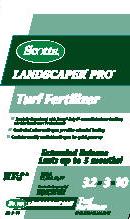Lawn Fertilizer Challenges

Sweeping changes are taking place across this country as to who can apply fertilizer and what types of fertilizers can be applied.
Various city and state governments are passing regulations, rules and laws to control the use of phosphorus fertilizers for lawn use. Pollution of the lakes and streams from turf area runoff has been a concern for many years.
In waterways, phosphorus behaves as a fertilizer, accelerating plant and algae growth. When plants and algae die, bacteria consume oxygen that is dissolved in the water. When this happens, less oxygen is available for fish and aquatic life that need oxygen to survive. Excess phosphorus in drinking water is difficult to remove, and also can require an increase in treatment chemicals which adds cost.
Many Universities have been for years, calling for lawn fertilizers such as 18-0-10 or 25-3-11 or equivalent to be used on lawns. I started to recommend these ratios back in the late 1960's when the common lawn fertilizer on the market was 12-10-5 and it was not a slow release type fertilizer commonly used today.
I was in Northern Indiana with the Purdue University Extension Service back in the 60's and early 1970's. Homeowners had lawns that were not growing properly. After reviewing many lawn soil tests, I found that most of these lawns had very high phosphorus concentrations almost double or triple that of the highest level on the test chart.
The only time that lawns need phosphorus is in the establishment of new lawns. Phosphorus should be placed near the grass seeds during new planting to assure rapid establishment and deep root growth. Most fertilizer companies have a "Starter Fertilizer" (18-24-6) for starting new lawns. When starting a new lawn, it may be OK to use a starter fertilizer. Check with your local city or county codes to make sure that they allow starter fertilizers usage.
Plants also use phosphorus in the reproductive portion of the plant, but when growing lawn grasses, we are not interested in producing seeds, allowing the seed to form means less growth and development of the grass itself.
The phosphorus content is quite immobile in the soil and does not move down into the soil through leaching unless the soil is very sandy. Phosphorus will remain very near the surface of the soil where it was applied during fertilizer applications.
In conclusion, only apply lawn fertilizers with little or no phosphorus. If you are having a lawn treatment company applying your application, check with them to make sure they are following the new rules.
For more Landscape information go to https://www.web-landscape-design-ideas.com
Online Landscape Design Services since 2003 and Do-It-yourself Landscape help.
53 years in the Landscape business world including 12 years as a Purdue University Extension Turf and Landscape Specialist and 41 years in private business.
Article Source: https://EzineArticles.com/?expert=Lawrence__L._Hoyle
Have A Great Story About This Topic?
Do you have a great story about this? Share it!
Order Your New Landscape Design Today!
Always Design Before You Plant!
Click The Above Link To Get Your Dream Design Started Now!

Privacy Disclaimer About Contact This Site Built: Solo Build It
Copyright © 2003 - 2023 by Web-Landscape-Design-Ideas.com.
All rights reserved.

